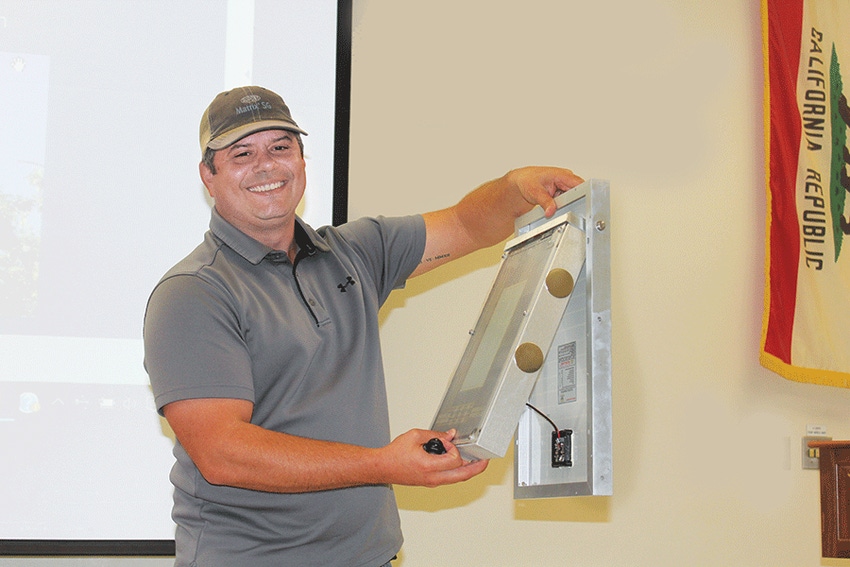October 3, 2018

A serious summit on the subject of mating disruption and its role in the fight against navel orangeworm, for the past two years a threat to growing almonds, was not without humor when Joe Coelho, crop advisor and agronomist with Valley Orchard Management at Fresno, trotted out a bug zapper he has used in his almond and pistachio orchards.
The zapper, powered by solar collectors, has done such a good job of attracting all sorts of bugs, he says, that it’s a challenge to sort out which are related to navel orangeworm (NOW) and which are not, unless users are trained to recognize the pest. “The bug zapper light attracts all sorts of bugs — along with thieves and meth heads who steal the solar lights.”
“Maybe you need a thief zapper,” quipped David Haviland, University of California Cooperative Extension advisor for Kern County, to laughter from the dozens of participants at the workshop at the Kearney Agricultural Research and Extension Center at Parlier.
Coelho explained that he isn’t promoting the use of the zapper; he’s just testing it. But it’s an indication of the interest in finding something — anything — that can address the serious problem of losses that have occurred the past two years, particularly for almond growers, because of the insect.
TWO WORST YEARS
“Last year, we were hammered by the navel orangeworm,” said Kris Tollerup, UC Cooperative Extension advisor for Kings, Tulare, Fresno, and Madera counties. That year and the one before were two of the worst NOW-challenged years ever. “We have the insecticides and mating disruption tools we need to combat it, so were we caught flat-footed?”
As growers are wont to do, some blamed the weather for the NOW losses in 2016 and 2017. It was too wet to get into orchards early in 2016 to address the problem of over-wintering pests in mummies on the trees and on the ground. And in 2017, it was so dry that there wasn’t the rain to bring mummies down, and growers waited too long to address the issue of sanitation in orchards. Some said labor costs were so high that they backed off on orchard sanitation.
Some said it may be time to revisit the idea of May spraying, which in recent years has been considered far less important than spraying as hull split nears late in the season. Others wondered if there might be new technologies that would make it easier and cheaper to get mummies off the trees to destroy the pest.
A COMBINATION APPROACH
There seemed a consensus among workshop speakers that mating disruption should be combined with pesticide use and good sanitation to counter the pest. Haviland posited that notion, addressing whether doing so pencils out for growers. His bottom line: It does, even if the $110 to $120 spent on mating disruption and the $40 to $60 spent on pesticides merely matches the $200 added return from delivering nuts that may be 50 percent free of NOW damage.
It brings money to growers’ pockets, Haviland says, because of bonuses they get from hullers to whom they deliver a crop that would otherwise have 50 percent more NOW damage.
Haviland and others discussed four mating disruption products from Suterra, Pacific Biocontrol, Semios, and Trece. He says product efficacy is comparable among the products. He cited trials that showed a reduction in damage caused by NOW when using a combination of mating disruption and insecticides. Benefits are greatest in larger plots, and cost/benefit ratios would be higher in higher pressure orchards and lower in lower pressure orchards.
BEFORE EMERGENCE
Jhalendra Rijal, UC Cooperative Extension advisor in San Joaquin, Stanislaus, and Merced counties, said it is important to place dispensers in the filed before moths emerge in the spring, and that they continue to be used during the susceptible stages of the crop. He recommends distributing dispensers in a grid pattern, “plus a few more on upwind edges to compensate for wind influence.”
Both Rijal and Haviland noted the importance of taking winds into account, pointing out the role they can play in dispersing mating disruption sprays. Both also recommended encouraging neighbors to also use the products in order to boost the odds that sprays will be dispersed into orchards. Rijal says dispensers should be placed on a limb close to the center of the tree and at one-third of its height.
Tollerup stressed the importance of monitoring for NOW, and gathering information that could influence decisions to spray or not to spray. Criteria can include the number of eggs and female moths found, along with the proportion of infested early split nuts.
Chuck Burks, research entomologist with the USDA Agricultural Research Service at Parlier, discussed attractants in lures. They include PPO (phenyl propionate) and a Kairomone blend. He says both are enhanced by pheromone, and the PPO performs better than the blend. “Interpretation of captures in these traps is still a work in progress,” Burks says.
PROVEN BENEFITS
Brad Higbee, Trece Inc. research entomologist and field research and development manager, said NOW damage was at historic levels in 2017, the highest seen since 2006 in many orchards.
As for insecticides, he believes tank mixes, including a pyrethroid, are required for the most impact, and that residue loading prior to harvest is a very effective strategy.
There are proven benefits in almonds — and more recently pistachios — for use of mating disruption, he says, noting that pyrethroid performance is waning, heavy pressure areas will require multiple insecticide applications, and mating disruption and lower pressure areas can be controlled with mating disruption or one or two sprays.
“Combining insecticides with mating disruption results in the lowest damage in all situations,” Higbee says.
About the Author(s)
You May Also Like




